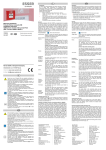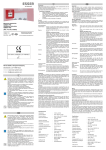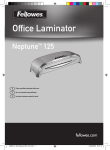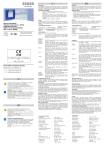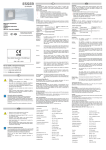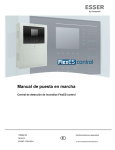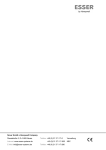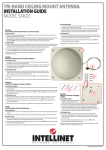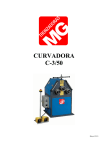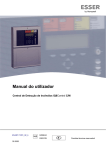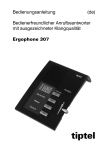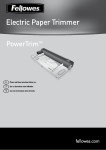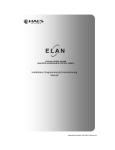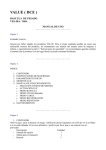Download Manual de Instalación Pulsador Manual Compacto Convencional
Transcript
Manual de Instalación Pulsador Manual Compacto Convencional Installation Instruction Electronic module / Conventional MCP (Ref. / Part No. 804950 / 804970) 798935 03.2006 Cambios técnicos reservados! GB Technical changes reserved! E GB Importante! Se declina toda responsabilidad sobre daños derivados y garantía por no seguir estas instrucciones de instalación. Estas instrucciones deben ser tenidas en cuenta cuidadosamente antes de proceder a la puesta en marcha del módulo electrónico / Pulsador Manual de Alarma. Información de seguridad • NUNCA conecte el pulsador directamente a 220V ac • Instale el pulsador dentro el rango de temperatura especificado. • Solo técnicos cualificados que estén familiarizados con los riesgos específicos y las normativas correspondientes deben llevar a cabo las operaciones de reparación y mantenimiento del Pulsador. • El pulsador no debe ser alterado ni modificado. Important! Any damage caused by failure to observe the installation instructions voids the product guarantee. Furthermore, no liability can be accepted for any consequential damage arising from such failure. These instructions must be studied carefully before commissioning the conventional Electronic module / Manual Call Point (MCP). General El pulsador electrónico (Ref. 804950) ) o el pulsador manual (Ref. 804970) con carcasa roja está identificado con un símbolo de una “casa ardiendo” para activación manual de sistemas de alarma u otros sistemas en espacios secos no sujetos a riesgos de explosión. El pulsador también está disponible en otras versiones para otras aplicaciones, por ejemplo en carcasas de diferentes colores y con elección de diferentes colores o etiqueta de identificación (ver tabla página 2). Funccionamiento Activar Alarma: Revise ésta información! Presione el cristal hacia adentro hasta que aparezca la lengüeta amarilla (G) en la zona superior de la ventana y el LED Rojo (F) parpadee (Fig. 4). Suba la cubierta de llave (A) e inserte la llave (Fig. 1).. Rearme Pulsador con Cristal Abra la caja y retire el cristal. Gire la llave (C) en sentido horario hasta el tope derecho (L) (Fig. 5). Abra la cubierta y reemplace el cristal, gire la llave en sentido contrahorario hasta el tope izquierdo (M) para subir la lámina (Fig. 6). Safety information • NEVER connect the MCP directly to a 230V AC mains power supply. • Only operate in the specified ambient temperature range. • Only qualified technicians who are fully familiar with all the associated hazards and the applicable legislation and regulations may perform maintenance and repair work on the call point. • The call point may not be changed or modified in any way. General The conventional Electronic module (Part No. 804950) or Manual Call Point (Part No. 804970) in the red housing identified with a “burning house” symbol is designated for use as a call point for manually triggering fire alarms or other hazard alarms in dry workplaces not subject to explosion hazards. The call point is also available in other versions for other applications, for example in housings with different colours and with a choice of different identification labels (refer to table - page 2) Operation Trigger alarm: Push up the keyhole cover (A) to insert the key (Fig. 1). Reset: Novar GmbH a Honeywell Company Instalación Montaje empotrado: Dieselstraße 2, D-41469 Neuss Montaje en Superficie: Internet: www.novar.de E-Mail: [email protected] Apertura: Cuando se usa un Pulsador como pulsador de Alarma, se debe usar una carcasa roja con una etiqueta de identificación con el símbolo correcto como es mostrado en Fig. 3 y 4. Cuando se usan diferentes carcasas o diferentes símbolos, el equipo está clasificado como equipo de activación y no como Pulsador de Alarma Observe la secuencia correcta del cableado: Terminales 1-4: 1 (- Entrada), 2 (- Salida), 3 y 4 (+Común) Use cable de comunicaciones claramente identificado I-Y (St) Y n x 2 x 0.8 mm o cable para alarma de incendio! La conexión de la malla del cable debe realizarse al Terminal de tierra para evitar interferencias. Se debe tener en cuenta durante el mantenimiento o labores de reparación la activación de sistemas de aviso como por ejemplo activación a central receptora. Cierre: Símbolo: Etiqueta: GB When the MCP is used as a manual call point it must be installed in a red housing with an identification label showing the standardize-conformal symbol as shown in Fig. 3/4. When housings with different colours and identification labels are used the unit is classed as a manual activation device and not as a manual call point. El pulsador puede instalarse sobre caja de mecanismo estándar (Ø 55 – 60mm) El pulsador se instala sobre caja de superficie (opcional) o con marco de montaje universal (opcional). Instale el Pulsador de un modo seguro, en una pared apropiada sobre una superficie lisa, con los tornillos y tacos adecuados. (Fig. 7/8). Inserte la llave por sus dos patillas en los orificios inferiores de la cubierta (abajo). Presione hacia arriba para liberar la tapa (Fig. 2). Tire desde abajo hacia fuera hasta retirar la tapa. Gire la llave en sentido contrahorario hasta su tope izquierdo (M) (Fig. 6). Coloque la lengüeta superior de la cubierta sobre las ranuras del módulo del pulsador y presione hasta encajar la cubierta en su posición. Abra la carcasa como se ha indicado y quite la lámina transparente de plástico (D/E) presionando hacia afuera, coloque el pictograma adecuado en el frontal, coloque de nuevo la lámina transparente sobre el nuevo pictograma y presione hasta su posición (Fig. 3). Para indicar equipo fuera de uso (J). Lámina de Gire la llave en sentido horario hasta el tope plástico o cristal: derecho (L) (Fig. 5). Inserte la lámina o cristal en su posición (H/K) en el hueco frontal deslice la lámina hacia arriba girando la llave en sentido contrahorario hasta su tope (M) (Fig. 6). Terminales: Los terminales 1-4 pueden extraerse para facilitar la instalación (Fig. 10). Use junta de paso para cableado para evitar el acceso de humedad. Siguiendo normas de instalación de VdS no es posible configurar Pulsadores y Detectores en la misma zona de Detección (max. 10 MCP por zona) Si se usa el marco de montaje (Ref. 704967) deberá montarse la cubierta blanca. Gire la llave (C) en sentido horario hasta el tope derecho (L) hasta que la lámina caiga y se indique la activación (F/G) (Fig. 4). Para rearmar el equipo gire la llave en sentido contrahorario hasta el tope izquierdo (M), para subir la lámina. Cubierta Abatible: Ref. 704965 (opcional) La pantalla del cable debe interconectarse en regleta separada. La caja de superficie tiene un terminal apropiado para conectar la pantalla (opcional) (Fig. 7). Para proteger de activaciones no intencionadas y para aumentar el grado de protección de IP 43 a IP 55. La cubierta abatible (N) se inserta en los orificios laterales (O) de la carcasa y puede precintarse en caso necesario (B) (Fig. 2/9). Instalación típica (Fig. 10) El pulsador convencional puede conectarse a la zona de incendios de un panel convencional o a la entra de de un transponder esserbus® en paneles 8000/IQ8Control de detección de incendio. Conecte los cables de zona a los terminals 1-4 (Fig. 10). El ultimo pulsador de la zona debe terminarse con la Resistencia de control de línea, habitualmente 10KΩ en las zonas convencionales de equipos de ESSER. Observe the correct wiring sequence! Terminals 1-4 (1 IN, 2 OUT, 3 u. 4 C) Use designated communication cable I-Y (St) Y n x 2 x 0.8 mm or fire alarm cable! Connection of the cable shield to the ground terminal protects the signal cables against interference. The alarm activation and triggering of notifying systems e.g. manned centre link (Master box) must be observed during any Service of the MCP. Install inlying cable with a dripping bend to protect the device from dampness. Pursuant to the VdS guidelines MCPs and automatic fire detectors must not be operated in a common detector zone (max. 10 MCP per detector zone). By using the mounting frame (Part No. 704967) the white covering must be fitted. Características Técnicas Alimentación Tensión de funccionamiento Consumo alarma Número Pulsadores Indicación alarma Terminales Temperatura trabajo Temperatura almacenamiento Grado de protección Caja Color Peso Dimensiones (a x h x f) Diemnansiones c/ caja sup. Especificación Certificado VdS : : : : : : : : : : : : : : : : : 8 V cc a 30 V cc 9 V cc 9 mA aprox. A 9Vcc max. 10 por zona (VdS) LED rojo / lámina amarilla 2,5 mm² máx. (AWG 26-14) -20 °C a +70 °C -30 °C a +75 °C IP 43 (en carcasa) IP 55 (con cubierta abatible) Plástico PC/ASA Rojo (similar RAL 3020) 110 g aprox. 88 x 88 x 21 (mm) 88 x 88 x 57 (mm) EN 54-11, Typ A G 205131 Detector with glass screen Open housing and remove the broken glass. Turn key (C) clockwise until the right (L) stop position (Fig. 5). Replace glass screen and turn key (M) anti-clockwise until the left stop position to lift screen upwards (Fig. 6). Pulsador con lámina rearmable Gire la llave (C) en sentido horario hasta el tope derecho (L) (Fig. 5). Coloque la lámina (K) correctamente y gire la llave en sentido contrahorario hasta el tope izquierdo (M) para subir la lámina (Fig. 6). Prueba: Observe Info! Press screen centre inwards until the yellow tab indicator (G) is visible in the upper area and the red LED (F) is flashing (Fig. 4). Detector with plastic operating panel Turn key (C) clockwise until the right (L) stop position (Fig. 5). Align the plastic operating panel (K) and turn key (M) anti-clockwise until the left stop position to lift screen upwards (Fig. 6). Test mode: Installation Flush mounting Turn key (C) clockwise (L) until the screen moves downwards and the activation (F/G) is indicated (Fig. 4). To reset the detector after a test simply turn key (M) to the left stop position to lift screen upwards. The Manual Call Point is installed on a conventional standard housing (Ø 55 – 60mm). Surface mounting The Manual Call Point is installed on a back box for surface mounting (option) or with an universal installation frame for wall mounting (option). The call point securely on a suitable wall with a smooth surface, e.g. with 2 screws (length ≥ 40mm) and dowels (S6) (Fig. 7/8). Opening: Insert the key with the both tenons in the opening at the bottom of the housing (Fig. 2) to release the cover lock. Lift up the bottom edge of the cover a little to release it and then remove it. Closing: Turn key lock anti-clockwise until the left (M) stop position (Fig. 6). Position the upper edge of the cover in the groove at the top of the base and then press the cover down until it locks into position. Symbolism: Open the housing and remove the transparent plastic cover (D/E) by prising it out. Insert the appropriate identification label from the front. Align the cover and snap it back into place (Fig. 3). Paper inlay: To indicate that the detector is out of order (J) Plastic operating Turn key lock clockwise until the right (L) stop panel or position (Fig. 5). Insert screen (H/K) aligned in the glass screen: front recess und move screen upwards by turning the key anti-clockwise until the left (M) stop position (Fig. 6). Terminals: The screw terminals 1-4 can be removed to simplify the installation (Fig. 10). The cable shield of the connection cable must be interconnected by using a single terminal block. The back box (option) provides an integrated screw terminal for the shield connection (Fig. 7). Hinged cover: Part No. 704965 (Option) To protect the detector for unintended activation and to increase the protection rating from IP 43 up to IP 55.The hinged cover (N) is fixed by the sideway dents (O) of the housing and may be plumbed (B) if required (Fig.2/9). Typical wiring (Fig. 10) The MCP can be connected to a conventional detector zone of a fire alarm control panel or to the zone input of an esserbus® transponder in a System 8000 or IQ8Control fire alarm control panel. Connect the signal cable to terminals 1-4 (Fig. 10). The last call point in the zone must be fitted with a terminating resistor. This should be a 10KΩ resistor for all Esser conventional detector zones. Specification Power supply range Operation voltage Alarm current MCP per zone Alarm indicator Connection terminals Application temperature Storage temperature Protection rating Housing Colour Weight Housing dimensions (w x h x d) Dimensions with back box Call point specification VdS approval : : : : : : : : : : : : : : : : : 8 V DC to 30 V DC 9 V DC approx. 9 mA @ 9 V DC max. 10 MCP (acc. to VdS) red LED and yellow tab max. 2.5mm² (AWG 26-14) -20 °C to +70 °C -30 °C to +75 °C IP 43 (in housing) IP 55 (with hinged cover) PC/ASA plastic red (similar RAL 3020) approx. 110 g 88 x 88 x 21 (mm) 88 x 88 x 57 (mm) EN 54-11, type A G 205131 E GB Opción Ref. Options Part No. Carcasa Azul similar RAL 5015 704951 Housing for MCP, blue similar to RAL 5015 704951 Cristal de repuesto (10 Uds.) 704960 Replacement glass screen (10 pieces) 704960 Etiqueta transparente para impresión de otros iconos (10 Uds.) 704961 Label, transparent with whit printing, differing from standard icons (10 pieces) 704961 Lámina de plástico rearmable (L) (10 Uds.) 704964 Plastic operating panel (K) resettable, white (10 pieces) 704964 Cubierta transparente abatible (O) para protección de activaciones no intencionadas y aumento de grado de protección IP 43 a IP 55 704965 Hinged cover (N) to protect the detector for unintended activation and to increase the protection rating from IP 43 up to IP 55 704965 Llave de repuesto (10 Uds.) 704966 Replacement key (10 pieces) 704966 Marco de monataje para pulsador compacto rojo + blanco (132 x 132 x 8 mm) 704967 Frame for small Manual Call Points incl. cover red + white (132 x 132 x 8 mm) 704967 Caja de montaje en superficie rojo similar RAL 3020 704980 Back box for surface mounting, red similar to RAL 3020 704980 Caja de montaje en superficie azul similar RAL 5015 704981 Back box for surface mounting, blue similar to RAL 5015 704981 Instalación / Mounting 21 D 15 88 88 B E C A Fig.1: Dimensiones Fig. 1: Dimensions Figura 2: Apertura de la tapa / carcasa Fig. 2: Open the housing / seal Figura 3: Etiqueta de identificación Fig. 3: Identification label Glasscheibe Cristal/Glass Glass screen F Oben Arriba Top Top G J Papiereinleger Indicador de Papel / Paper inlay inlay Paper Out of Order Außer Betrieb Oben Arriba Top Top K 704964 ) Kunststoffbedienfeld (Art.-Nr. Lámina rearmable Ref.704964 Plastic panel (PartPart.Nº No.704964) Plasticoperating operating panel 704964 Arriba Oben Top Top L M L Figura 4: Indicacidores LED y cubiertas de Plástico rearmable, cristal y papel fuera de uso Fig. 4: Mechanical alarm indicator and LED, Glass screen, paper inlay and plastic operating panel Figura 5: Posición de llave para prueba / extraer cristal Fig. 5: Key lock position for test mode and removing screen Figura. 6: Posición de llave para rearme / insertar cristal Fig. 6: Key lock position for Reset / Replace screen 132 36 88 O N THIS WAY UP 88 50 132 18,5 44 Figura 7: Caja de montaje en superficie (Ref. 704980) Fig. 7: Back box for surface mounting (Part No. 704980) Figura 8: Marco de montaje universal (Art.-Nr. 704967) Fig. 8: Universal installation incl. cover (Part No. 704967) Figura 9: Cubierta abatible (Ref. 704965) Fig. 9: Hinged cover (Part No. 704965) 8 7 6 5 C4 3 OUT 2 IN 1 8 7 6 5 C4 3 OUT 2 IN 1 8 7 6 5 C4 3 OUT 2 IN 1 System 8000 / IQ8Control Nächster Melder oder Siguiente equipo o final Abschlusswiderstand (R)de línea EOL (resistencia). Revise la (Erforderlicher Widerstandswert documentación de la central o siehe Dokumentantion der Zentrale) equipo al que conecte el pulsador para el valor del final de línea Next detector or End-Of-Line resistor (R). (Refer to Panels manual for required resistance) Meldergruppe / Detector zone MG / Zone # + MG / Zone # - Fig. 10: Instalación en zona convencional Fig. 10: Wiring of the conventional detector zone + - R


